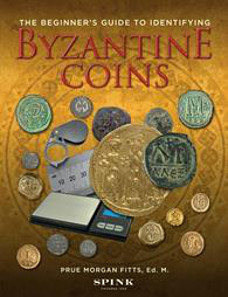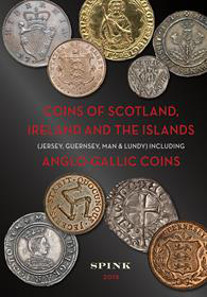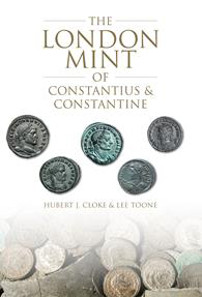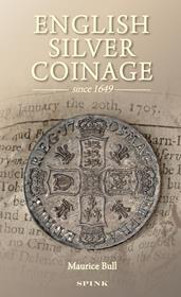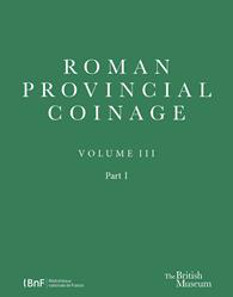July 2, 2015 – Book publisher Spink has issued new books ranging from a beginner’s guide to Byzantine coinage to coins of the Late Roman Empire, medieval Britain, and a new volume of the prestigious Roman Provincial coinage series.
The Beginner’s Guide to Identifying Byzantine Coins by Prue M. Fitts (£20.00)
This book covers coins of the Eastern Roman Empire from Anastasius I (491-518) to Constantine XI (1448-1453) with an overview of the period of Diocletian in 284 to the succession of Anastasius I as an introduction to the coinage. It is not intended to be a scholarly book but rather a quick reference for coin identification. It does not cover the holdover aureus from the Western Empire, coins from the collateral areas of the Arab-Byzantine, or the coins of the Turks and other successors who produced coins of similar design. It also does not cover forgeries. Caveat Emptor. This book is dedicated to, and specifically designed for, the beginning collector of Byzantine coins. Identification can be a challenge particularly with those coins which are the most affordable. You may have to begin with coins which have only partial legends and worn-off designs. Most coins carry enough information for you to unravel their identity. This book is full of clues that can help you turn your coin’s observable features into solid identification.
Coins of Scotland, Ireland, the Islands and Anglo-Gallic Coinage. 3rd Edition by P. Skingley (ed.) (£35.00)
The third revised edition of this classic catalogue. Featuring all major coin types, updated values, and now expanded to include a section on Anglo-Gallic coinage. An essential guide for beginners, serious numismatists, metal detectorists and anyone interested in the coinage of the British Isles. Fully illustrated with high quality actual size photographs in colour throughout.
The London Mint of Constantius & Constantine by Hubert J Cloke & Lee Toone (£50.00)
This book is a comprehensive catalogue and survey of the output of the London mint from AD 296 when Constantius I invaded Britain to wrest the ‘Britannic Empire’ from Allectus, to its closure in 325 when his son and successor, Constantine I, began to shift his power base to the East. During this period the London mint was responsible for a vast output of Roman coinage.
The authors of this book have expanded the number of known London types from the 617 recorded in Volume VI and VII of The Roman Imperial Coinage (RIC), to 1,037, 90 per cent of which are illustrated on plates facing the catalogue tables in sylloge format. Supported with historical background narratives, indices, and a concordance with RIC, the catalogue also includes a hoard census which lists numbers of coins for each type found in four major hoards. This enables an objective rarity value to be assigned to each coin type.
This book proposes to become the standard reference work on the London mint for years to come and invites the reader to become part of the on-going construction of this catalogue as new types are discovered and recorded.
English Silver Coinage Since 1679 by M. Bull (£40.00)
This new 6th edition offers much more than any previous editions, not only in terms of the number of varieties recorded but also in terms of the way in which the data has been recorded and presented. The book now runs to 680 pages, some 400 pages more than the last edition and has also been completely renumbered to do away with the confusing letter suffixes used in previous editions.
The arrangement of this new edition is also now done by monarch rather than denomination, and all of the new numbers are cross-referenced to the previous edition.
A new section on Provenances has been added to this edition which lists the instances of illustrations of coins and where they have appeared, thus proving the existence of many rare examples or those only rumoured to exist. The rarities of the coins have also been completely re-assessed in the light of current evidence.
This is not intended to be a complete record of every silver coin and variety in existence but the major and many minor recognised types and die-varieties. Some so-called varieties have actually been removed from the listings since they are considered to be the result of striking flaws or filled dies and not true die sinker’s errors.
The result is a truly astonishing piece of work by Maurice Bull who is now embarking on a companion volume for the gold coinage.
Roman Provincial Coinage III; Nerva, Trajan and Hadrian (AD 96-138). 2 volumes, Hardback in slipcase, 1368 pages, 356 black & white plates and 5 black & white maps. (Pre-order price: £175.00/ Retail: £195.00)
This publication will be released in September 2015 and is available for pre-order now.
This volume presents for the first time an authoritative and systematic account of the coins minted in the Roman provinces during the period from the accession of Nerva in AD 96 to the death of Hadrian in AD 138 and includes the three reigns of Nerva (AD 96-98), Trajan (AD 98-117) and Hadrian (AD 117-138).
The book gives a complete picture of the material, thereby not only meeting the needs of numismatists but also providing an essential reference for historians, archaeologists and other students of the Roman empire. The introductory essays are followed by indexes and an illustration of every major issue listed.
The book catalogues over 50,000 coins classified into 7,000 main varieties from the world’s principle collections, including the British Museum and Bibliotheque nationale de France. These were minted at 300 cities located throughout the eastern part of the Roman Empire, from Appollonia in Albania to Trapezus in Turkey and from Tomi in Romania to Alexandria in Egypt. The catalogue includes the extensive coinages made by the cities of the Roman province of Asia and the complex coinage from Alexandria in Egypt.
You can order these books on the website of Spink.




